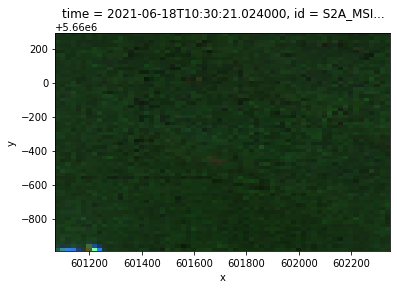Add stackstac keyword arguments¶
In this tutorial we will learn how to pass stackstac arguments to cubo.
[1]:
import cubo
The following chunk doesn’s pass any argument to stackstac, creating the cube using the default values:
[2]:
da = cubo.create(
lat=51.079225, # Central latitude of the cube
lon=10.452173, # Central longitude of the cube
collection="sentinel-2-l2a", # Name of the STAC collection
bands=["B02","B03","B04"], # Bands to retrieve
start_date="2021-06-01", # Start date of the cube
end_date="2021-07-01", # End date of the cube
edge_size=64, # Edge size of the cube (px)
resolution=20, # Pixel size of the cube (m)
query={"eo:cloud_cover": {"lt": 10}} # kwarg for pystac-client
)
da
/home/dmontero/anaconda3/envs/cubo/lib/python3.9/site-packages/stackstac/prepare.py:364: UserWarning: The argument 'infer_datetime_format' is deprecated and will be removed in a future version. A strict version of it is now the default, see https://pandas.pydata.org/pdeps/0004-consistent-to-datetime-parsing.html. You can safely remove this argument.
times = pd.to_datetime(
[2]:
<xarray.DataArray 'sentinel-2-l2a' (time: 2, band: 3, y: 64, x: 64)>
dask.array<fetch_raster_window, shape=(2, 3, 64, 64), dtype=float64, chunksize=(1, 1, 64, 64), chunktype=numpy.ndarray>
Coordinates: (12/47)
* time (time) datetime64[ns] 2021-06-13...
id (time) <U54 'S2B_MSIL2A_20210613...
* band (band) <U3 'B02' 'B03' 'B04'
* x (x) float64 6.011e+05 ... 6.023e+05
* y (y) float64 5.66e+06 ... 5.659e+06
sat:orbit_state <U10 'descending'
... ...
title (band) <U20 'Band 2 - Blue - 10m...
common_name (band) <U5 'blue' 'green' 'red'
center_wavelength (band) float64 0.49 0.56 0.665
full_width_half_max (band) float64 0.098 0.045 0.038
epsg int64 32632
cubo:distance_from_center (y, x) float64 908.2 ... 873.7
Attributes:
collection: sentinel-2-l2a
stac: https://planetarycomputer.microsoft.com/api/stac/v1
epsg: 32632
resolution: 20
edge_size: 64
central_lat: 51.079225
central_lon: 10.452173
central_y: 5659638.0946523
central_x: 601722.4825156148
time_coverage_start: 2021-06-01
time_coverage_end: 2021-07-01Let’s visualize an image:
[3]:
(da.sel(band=["B04","B03","B02"])[1]/2000).clip(0,1).plot.imshow()
[3]:
<matplotlib.image.AxesImage at 0x7f11eab43220>

Now, let’s modify these default values by passing the required modifications as a dictionary.
[4]:
from rasterio.enums import Resampling
da = cubo.create(
lat=51.079225, # Central latitude of the cube
lon=10.452173, # Central longitude of the cube
collection="sentinel-2-l2a", # Name of the STAC collection
bands=["B02","B03","B04"], # Bands to retrieve
start_date="2021-06-01", # Start date of the cube
end_date="2021-07-01", # End date of the cube
edge_size=64, # Edge size of the cube (px)
resolution=20, # Pixel size of the cube (m)
query={"eo:cloud_cover": {"lt": 10}}, # kwarg for pystac-client
stackstac_kw=dict( # stackstac keyword arguments
xy_coords='center',
resampling=Resampling.bilinear)
)
da
/home/dmontero/anaconda3/envs/cubo/lib/python3.9/site-packages/stackstac/prepare.py:364: UserWarning: The argument 'infer_datetime_format' is deprecated and will be removed in a future version. A strict version of it is now the default, see https://pandas.pydata.org/pdeps/0004-consistent-to-datetime-parsing.html. You can safely remove this argument.
times = pd.to_datetime(
[4]:
<xarray.DataArray 'sentinel-2-l2a' (time: 2, band: 3, y: 64, x: 64)>
dask.array<fetch_raster_window, shape=(2, 3, 64, 64), dtype=float64, chunksize=(1, 1, 64, 64), chunktype=numpy.ndarray>
Coordinates: (12/47)
* time (time) datetime64[ns] 2021-06-13...
id (time) <U54 'S2B_MSIL2A_20210613...
* band (band) <U3 'B02' 'B03' 'B04'
* x (x) float64 6.011e+05 ... 6.024e+05
* y (y) float64 5.66e+06 ... 5.659e+06
sat:orbit_state <U10 'descending'
... ...
title (band) <U20 'Band 2 - Blue - 10m...
common_name (band) <U5 'blue' 'green' 'red'
center_wavelength (band) float64 0.49 0.56 0.665
full_width_half_max (band) float64 0.098 0.045 0.038
epsg int64 32632
cubo:distance_from_center (y, x) float64 894.1 ... 887.9
Attributes:
collection: sentinel-2-l2a
stac: https://planetarycomputer.microsoft.com/api/stac/v1
epsg: 32632
resolution: 20
edge_size: 64
central_lat: 51.079225
central_lon: 10.452173
central_y: 5659638.0946523
central_x: 601722.4825156148
time_coverage_start: 2021-06-01
time_coverage_end: 2021-07-01Now let’s visualize the same image:
[5]:
(da.sel(band=["B04","B03","B02"])[1]/2000).clip(0,1).plot.imshow()
[5]:
<matplotlib.image.AxesImage at 0x7f11d9974f70>
